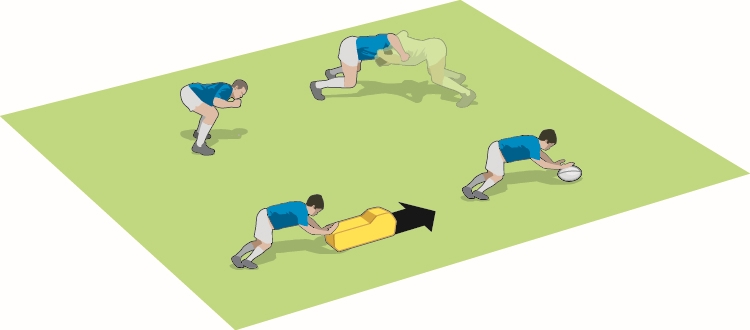You are viewing
1 of your 2 free articles
VIDEO: The 1,2,3,4 of scrum profiles
Scrums & Lineoutsby Dan Cottrell
Though there are lots of elements to a good, strong, scrummaging position, keep it simple once you have established the principles, so your players have got a template to work towards every scrum.
Go through the key building blocks for good scrummaging:

The hips are the most important element, check the tilt.
This scrum profiles session is a warm up for more scrummaging.
With older players, work on gentle one v one work. The players can bind and lean on each other, with one player slowly raising and lowering the height of both players. They can also move slowly side-to-side.
Further develop by putting one player against two. Only the one player pushes, the other two have to resist but not push back.
Go through the key building blocks for good scrummaging:
- Feet: around shoulder width apart, on the toes.
- Hips: tilt the hips so the backside is out.
- Scaps: pull the shoulder blades in towards each other – elbows bent and back (like chicken wings).
- Head: neutral so the chin isn’t on the chest or facing upwards.

- Crouch into the right position, balanced.
- Then lean on another player, to check that the knees are directly below the hips after the engagement.
- Warm up by pushing a ruck pad along the ground. Works on keeping the feet active, the hips square and the weight moving forwards not downwards.
- Have the player resting on a rugby ball in a scrum profile position. Use peer coaching, and have another player check the right body positions.
COACHING TIP
The hips are the most important element, check the tilt.
TECHNIQUE
- Knees below hips.
- Keep the scaps back at all times.
- Look through your eyebrows, so keeping your head neutral.
DEVELOP THE PRACTICE
This scrum profiles session is a warm up for more scrummaging.
With older players, work on gentle one v one work. The players can bind and lean on each other, with one player slowly raising and lowering the height of both players. They can also move slowly side-to-side.
Further develop by putting one player against two. Only the one player pushes, the other two have to resist but not push back.
Newsletter Sign Up
Coaches Testimonials

Gerald Kearney, Downtown Las Vegas Soccer Club

Paul Butler, Florida, USA

Rick Shields, Springboro, USA

Tony Green, Pierrefonds Titans, Quebec, Canada
Subscribe Today
Be a more effective, more successful rugby coach
In a recent survey 89% of subscribers said Rugby Coach Weekly makes them more confident, 91% said Rugby Coach Weekly makes them a more effective coach and 93% said Rugby Coach Weekly makes them more inspired.
Get Weekly Inspiration
All the latest techniques and approaches
Rugby Coach Weekly offers proven and easy to use rugby drills, coaching sessions, practice plans, small-sided games, warm-ups, training tips and advice.
We've been at the cutting edge of rugby coaching since we launched in 2005, creating resources for the grassroots youth coach, following best practice from around the world and insights from the professional game.
More from us
© 2023 Rugby Coach Weekly
Part of Green Star Media Ltd. Company number: 3008779
We use cookies so we can provide you with the best online experience. By continuing to browse this site you are agreeing to our use of cookies. Click on the banner to find out more.













